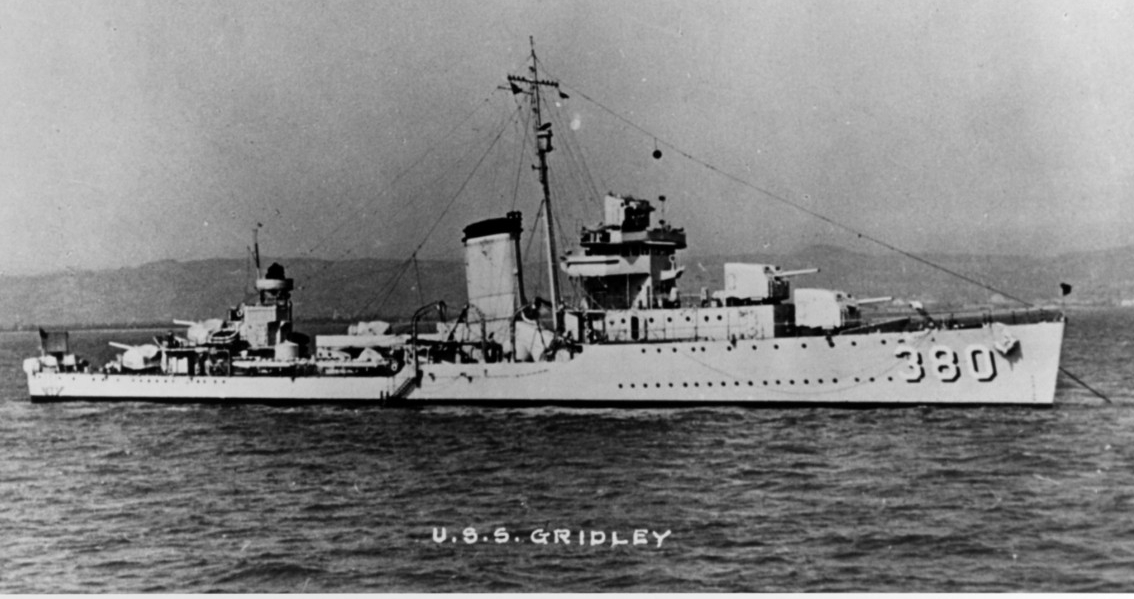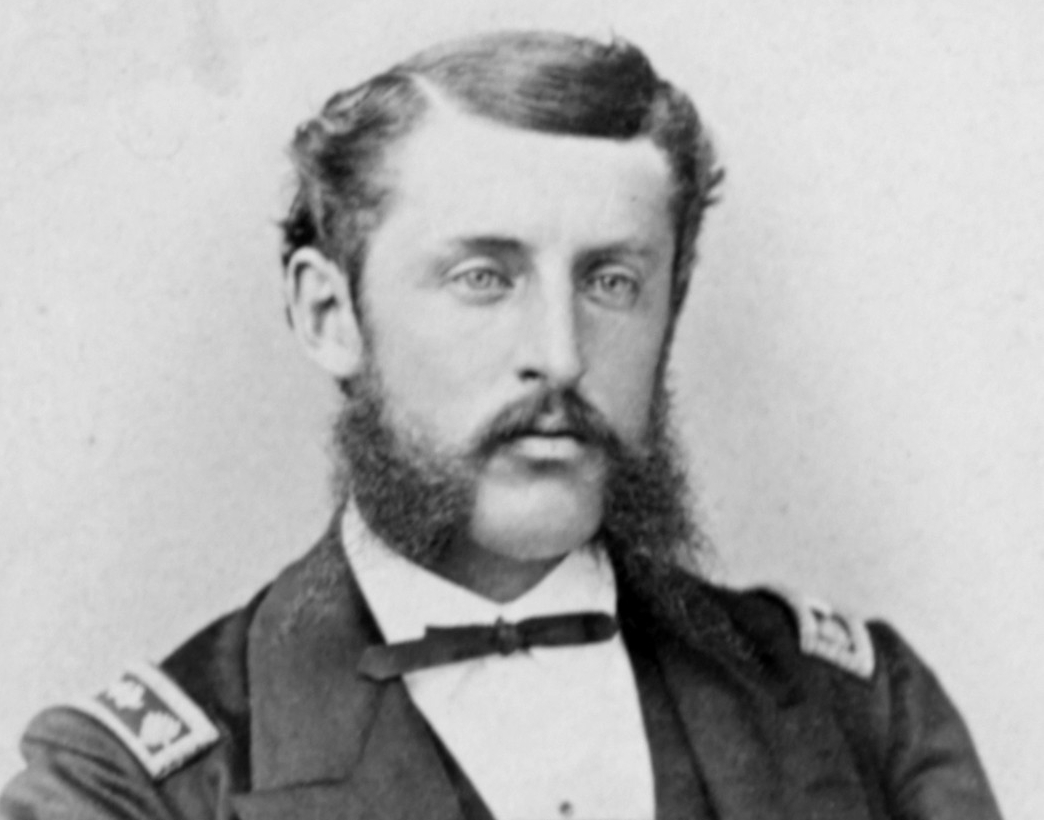Gridley II (DD-380)
(DD-380: dp. 1850; l. 341'5"; b. 35'6"; dr. 10'4"; s. 40 k.; cpl. 158; a. 4 5", 16 21" tt.; cl. Gridley)
Charles Vernon Gridley was born 24 November 1844 in Logansport, Ind., and was appointed to the Naval Academy in 1860. Reporting for duty with his class in September 1863, Gridley joind the sloop-of-war Oneida with the West Gulf Blockading Squadron and distinguished himself with Farragut at the Battle of Mobile Bay 5 August 1864. Promoted to Lieutenant in 1867 and Commander in 1882, he spent the next 30 years at various stations around the world, including a tour as instructor at the Naval Academy. Captain Gridley took command of Olympia, Admiral Dewey's famous flagship, 27 April 1898, a post which he held despite failing health during the Battle of Manila Bay 1 May 1898. It was that morning that Dewey gave his famous command: "You may fire when you are ready, Gridley," immortalizing the doughty captain. After the destruction of the Spanish squadron and the capture of Manila, Gridley was obliged to leave his command because of his health, and died en route to the United States at Kobe, Japan, 25 May 1898.
II
The second Gridley was launched at the Fore River plant of Bethlehem Shipbuilding Corp., Quincy, Mass., 1 December 1936; sponsored by Mrs. Lewis Buddy III, daughter of Captain Gridley; and commissioned 24 June 1937, Comdr. Leroy W. Busbey, Jr., in command.
Gridley fitted out at Boston Navy Yard, and conducted shakedown in the Caribbean area until 27 October 1938, visiting Puerto Rico, Cuba, and Venezuela. She then underwent alterations at the Boston Navy Yard until 13 June 1938, when she departed that port, transited the Panama Canal, and entered San Diego harbor 5 July 1938. Joining Destroyer Division 11, Gridley spent the next months in tactical maneuvers off the coast of California, and 4 January 1939 departed with the Battle Force for combined maneuvers in the Caribbean. She participated in Fleet Problem 20 with the Fleet off Cuba and Haiti, after which she returned to Boston for repairs.
The destroyer again sailed into San Diego 13 July 1939 and became flagship of Division 11. She conducted maneuvers off California until 2 April 1940, when Gridley and other ships of the fleet conducted Fleet Problem 21 in Hawaiian waters. Subsequently, Gridley operated out of Hawaii.
Gridley cleared Pearl Harbor 28 November 1941 as part of the antisubmarine screen for famed carrier Enterprise, flagship of Admiral Halsey, and after a stop at Wake Island, reversed course for Pearl Harbor. The Task Force was approaching that base on the morning of 7 December when the astounding message heralding the beginning of the war was received: "Air raid on Pearl Harbor, this is no drill." Gridley entered the harbor next day to help protect against renewed attack, and during the next 5 months was occupied escorting transports and repair vessels to and from Pearl Harbor and South Pacific ports. Her last such voyage was completed 27 May 1942 and 5 June she arrived at Kodiak, Alaska, with cruiser Nashville. In the Alaskan theater, Gridley escorted transports and patrolled the Japanese-held islands of Kiska and Attu, assisting in the bombardment of Kiska 7 August 1942. She acted during this period as flagship for famous destroyerman Comdr. Frederick Moosbrugger.
Departing Dutch Harbor 25 September 1942, Gridley joined the Saratoga task force in Hawaiian waters and later performed escort missions for both combatant and non-combatant ships in the Fijis and New Hebrides. In December 1942 she escorted oiler Cimarron out of Noumea to fueling rendezvous with the carrier task forces supporting the bitter fighting in the Solomons. Shifting her base of operations to Purvis Bay, in the Solomons, 13 July, Gridley guarded the high-speed transports which rescued survivors from Helena in Parasco Bay 16 July 1943, and teamed with destroyer Maury to escort infantry landing craft from Guadalcanal for the landings on Tambatuni, New Georgia. She bombarded shore installations near the invasion beaches 25 July and screened the ships supporting the landing. In company with six other destroyers she destroyed Japanese landing barges in Vella Gulf 10 August, and screened Saratoga during air operations in the Solomons until 25 August.
Gridley returned to Pearl Harbor with escort carriers Suwanee and Long Island 4 September 1943 and then departed for San Diego, where she remained for repairs 11 September to 26 October 1943. The Gilbert Islands were her next destination, and Gridley left Pearl Harbor once more 10 November 1943 for Makin Island. She assisted in the bombardment of that island, screened aircraft carriers, and then conducted independent patrol in the area until setting course for Hawaii 1 December.
Vice Admiral Marc A. Mitscher's Carrier Task Force 58 departed Pearl Harbor 18 January 1944 for the great offensive in the Marshalls, with Gridley again acting as screening ship for Saratoga. Gridley guarded the carrier during the crucial strikes against Wotje and Eniwetok, and 8 March sailed for the New Hebrides with carriers Yorktown, Princeton, and Langley, assisting them in support of the developing New Guinea offensive. The veteran destroyer sailed with the Hornet task force 7 June 1944 to take part in the invasion of the Marianas, where the carriers pounded Saipan, Rota, and Guam. In all these operations Gridley and her sister destroyers rendered invaluable service protecting the carriers against air and submarine attack.
Gridley was with American forces in the pivotal Battle of the Philippine Sea 19 to 20 June 1944, when four massive waves of Japanese torpedo bombers and escorting fighters were decimated by fleet air and surface units. Gridley's antiaircraft fire helped to protect the aircraft carriers, with the result that Japanese air strength was virtually ended with this battle.
Gridley departed Eniwetok Atoll 30 June 1944 bound with the carriers for strikes on Iwo Jima, Guam, Yap, Ulithi, and the Volcano Islands. She supported directly the American landings on Peleliu 15 September 1944, shooting down at least one Japanese attack plane. After screening the carriers in attacks on Okinawa and Formosa, Gridley joined the mounting American forces for the invasion of the Philippines. While protecting the large ships off Luzon 28 October 1944 she and destroyer Helm detected and sank Japanese submarine I-51f with a series of devastating depth charge attacks. In the succeeding days, Gridley fought off Japanese suicide planes and returned to Ulithi with damaged carriers Franklin and Belleau Wood 2 November.
Gridley was soon at sea again, however, clearing Ulithi 5 November with the fast carrier task force for the Leyte operation. She later joined a group of escort carriers and served as a bombardment and patrol ship during the landings in Lingayen Gulf until 10 February 1945.
After stopping again at Ulithi, Gridley escorted battleship Mississippi en route to Pearl Harbor, and then sailed via San Diego and the Panama Canal for New York, where she arrived 30 March 1945. She entered the New York Navy Yard next day for much-needed repairs, and after finishing her overhaul departed the United States 22 June.




